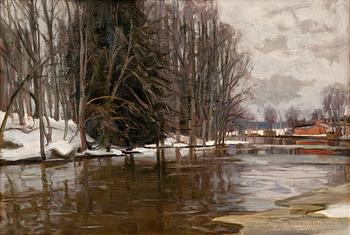Victor Westerholm
VIEW FROM MUSTIO.
Sign. Svartå 1 april 1917.
Oil on canvas, 45,5x67 cm.RIVER VIEW AT SVARTÅ, 1917.
Signed: Victor Westerholm/ Svartå 1 april 1917.
Victor Westerholm lived in Turku, but both of his parents came from Nauvo, a parish in the archipelago, which may explain why water was such an important element in Westerholm’s art and a recurring theme during the forty years of his artistic career. Already in the 1880s, Victor Westerholm had travelled to Åland in order to experience the close vicinity of the sea. At the turn of the century the artist was fascinated by the majestic allure of the river Kymijoki. At third important region, where Westerholm went in search of inspiration was western Uusimaa. Here, the idyllic, peacefulness of the landscape appealed to the artist. In the early spring of 1917, Victor Westerholm painted several works in Karjaa where he was staying with, amongst others, the factory owner and patron of the arts, Hjalmar Linder at Mustio Manor. This sojourn was to be Westerholm’s last visit to Karjaa.
From time to time, Victor Westerholm depicted barren land formations and nature that appeared to be untouched by man. This, however, wasn’t the case. The artist almost always painted his own interpretation of an inhabited landscape. This set him apart from those of his contemporary artist colleagues who preferred to paint wilderness. However, nature and the feeling that emanated from nature always play a central part in Westerholm’s work. Summer landscapes held a strong appeal for Victor Westrholm, but he was also fascinated by winter views. In time, Westerholm became a principled and dedicated plein-air painter who even worked outdoors during the coldest winter days, when the temperature dropped to forty degrees Celsius below zero.
The view that Westerholm painted at Mustio is a good example of his artistic ambition.
The foreground is dominated by flowing water in which a cloudy sky is reflected. During his stay at Karjaa Westerholm created several paintings that show his preoccupation with depicting moving water. In Victor Westerholm’s work, buildings become mere architectonic staffage, with the focus on the surrounding nature. The westerholm expert, professor Aimo Reitala, has established that, in his works, the artist tended to more or less erase factory buildings in order to enhance the landscape. In the view of Mustio, the presence of the factory is hinted at, with only one red-brick building visible on the opposite river bank.
The landscape is painted in the restrained palette that Westerholm favoured in his later work. Westerholm created this work only two and a half years before he unexpectedly died of pneumonia a couple months before his 60th birthday.
The original frame with its gilding in different degrees of shininess, adds historic value to the painting. Some of Westerholm´s works at Turku Art Museum have similar frames.
Christian Hoffmann
More information
VICTOR WESTERHOLM (1860 – 1919):
ÅLANDSKAP FRÅN SVARTÅ , 1917
Sign.: Victor Westerholm/ Svartå 1 april 1917.
Victor Westerholms båda föräldrar var hemma i Nagu skärgårdssocken och vatten var ett viktigt element































